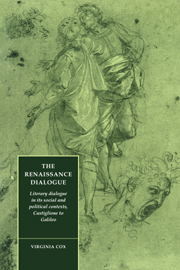 The Renaissance Dialogue
The Renaissance Dialogue Published online by Cambridge University Press: 05 December 2011
… recitaremo alcuni ragionamenti, i quali già passarono tra omini singularissimi a tale proposito …
Baldassare Castiglione, II libro del Cortegiano (1528)A crucially important structural variable in dialogues, unaccountably neglected by critics, is the historical consistency of their fictional exchange. A dialogue which purports to be a transcription of a real conversation, between speakers whom the reader may plausibly even know, will clearly demand an entirely different kind of reception than one which presents a discussion undefined by place or time, peopled by puppets whose character and views are clearly defined by their role in the economy of the dialogue.
The extent to which historical consistency conditions our reading of a dialogue can be illustrated by looking at a work which exists in both a ‘documentary’ and a fictional version. In the original version of Torquato Tasso's Malpiglio overo della corte (1585), Tasso's discussion of courtiership gains a crucial level of meaning from the identity of the protagonists he chooses. The speakers are a father and son, Lorenzo and Giovanlorenzo Malpiglio, and the author himself, in his customary Platonic guise as a ‘Neapolitan Stranger’. Giovanlorenzo is portrayed as a starryeyed youth, besotted with the glamour of the Ferrarese court, and incapable of imagining a higher calling than the service of a prince. His father, Lorenzo, has misgivings about this: an exile from the fallen republic of Lucca, he is mindful of the family's past as members of an independent ruling élite.
To save this book to your Kindle, first ensure [email protected] is added to your Approved Personal Document E-mail List under your Personal Document Settings on the Manage Your Content and Devices page of your Amazon account. Then enter the ‘name’ part of your Kindle email address below. Find out more about saving to your Kindle.
Note you can select to save to either the @free.kindle.com or @kindle.com variations. ‘@free.kindle.com’ emails are free but can only be saved to your device when it is connected to wi-fi. ‘@kindle.com’ emails can be delivered even when you are not connected to wi-fi, but note that service fees apply.
Find out more about the Kindle Personal Document Service.
To save content items to your account, please confirm that you agree to abide by our usage policies. If this is the first time you use this feature, you will be asked to authorise Cambridge Core to connect with your account. Find out more about saving content to Dropbox.
To save content items to your account, please confirm that you agree to abide by our usage policies. If this is the first time you use this feature, you will be asked to authorise Cambridge Core to connect with your account. Find out more about saving content to Google Drive.